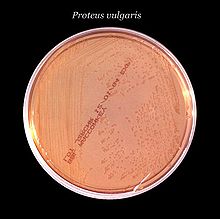MacConkey agar



MacConkey agar is a
Contents
It contains
Composition:[3]
- Peptone– 17 g
- Proteose peptone – 3 g
- Lactose – 10 g
- Bile salts– 1.5 g
- Sodium chloride – 5 g
- Neutral red – 0.03 g
- Crystal violet – 0.001 g
- Agar – 13.5 g
- Water – add to make 1 litre; adjust pH to 7.1 +/− 0.2
- Sodium taurocholate
There are many variations of MacConkey agar depending on the need. If the spreading or swarming of Proteus species is not required, sodium chloride is omitted. Crystal violet at a concentration of 0.0001% (0.001 g per litre) is included when needing to check if Gram-positive bacteria are inhibited. MacConkey with sorbitol is used to isolate E. coli O157, an enteric pathogen.[4]
History
The medium was developed by Alfred Theodore MacConkey while working as a bacteriologist for the Royal Commission on Sewage Disposal. [5]
Uses
Using neutral red pH indicator, the agar distinguishes those Gram-negative bacteria that can ferment the sugar lactose (Lac+) from those that cannot (Lac-).
This medium is also known as an "indicator medium" and a "low selective medium". Presence of bile salts inhibits swarming by Proteus species.
Lac positive
By utilizing the lactose available in the medium, Lac+ bacteria such as
Lac negative
Organisms unable to ferment lactose will form normal-colored (i.e., un-dyed) colonies. The medium may also turn yellow. Examples of non-lactose fermenting bacteria include Salmonella, Proteus, and Shigella spp..[4]
Slow
Some organisms ferment lactose slowly or weakly, and are sometimes put in their own category. These include Serratia[8] and Citrobacter.[9]
Mucoid colonies
Some organisms, especially Klebsiella and Enterobacter, produce mucoid colonies which appear very moist and sticky and slimy. This phenomenon happens because the organism is producing a capsule, which is predominantly made from the lactose sugar in the agar.
Variant
A variant, sorbitol-MacConkey agar, (with the addition of additional selective agents) can assist in the isolation and differentiation of enterohemorrhagic E. coli serotype E. coli O157:H7, by the presence of colorless circular colonies that are non-sorbitol fermenting.[4]
See also
- R2a agar
- MRS agar (culture medium designed to grow Gram-positive bacteria and differentiate them for lactose fermentation).
References
- ^ "MacConkey Agar". Texas Medical Center. Archived from the original on 2008-11-04.
- ISBN 978-1-269-39068-2.
- ^ "MacConkey Agar Plates Protocols". Archived from the original on 2010-12-03. Retrieved 2011-03-20.
- ^ ISBN 9781683670063.
- ^ Smith, Kenneth (2019-10-14). "The Origin of MacConkey Agar". American Society for Microbiology. Retrieved 2023-12-01.
- PMID 20474229.
- PMID 20474363.
- ISBN 1-55581-206-6.
- ^ "Medmicro Chapter 26". Archived from the original on 2008-07-06. Retrieved 2008-12-11.
